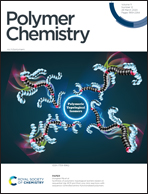Substrate-independent Cu(0)-mediated controlled radical polymerization: grafting of block copolymer brushes from poly(dopamine) modified surfaces†
Abstract
A method is presented allowing the preparation of polymer brushes from numerous monomers and on a variety of substrates. Poly(dopamine) (PDA) is used to cover a series of different surfaces (SiO2, Au, Cu, Al/Al2O3, Teflon) and for the subsequent preparation of bromine containing initiator layers by conversion with 2-bromoisobutyryl bromide (BiBB). Surface-initiated Cu(0)-mediated controlled radical polymerization (SI-CuCRP) enables a rapid polymerization of methacrylates and styrene on the PDA/BiBB layers with minimal effort. When the substrates are faced with a copper plate and submerged into reaction solution containing monomer, solvent and ligand, thick polymer brushes up to hundreds of nanometers can be achieved within 1 h. Despite the simplicity of the method and the fast polymerization rates at room temperature, an outstanding endgroup fidelity, which is unmatched for surface polymerization, can be observed. This fact is demonstrated by the preparation of pentablock copolymer brushes representing the highest block number ever reported for surface-bound polymer.



 Please wait while we load your content...
Please wait while we load your content...